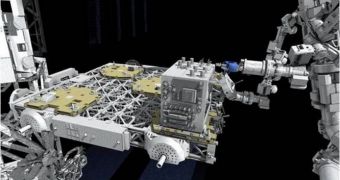When the space shuttle Atlantis will take off for the International Space Station (ISS) – on the last mission of the Space Shuttle Program (SSP) – it will carry a robotic experiment that could very easily change the way satellites are designed and built.
The orbiter will carry the Robotic Refueling Mission (RRM) experiment to low-Earth orbit (LEO). The technology demonstrator is designed to prove that it is possible to refuel satellites in orbit.
This gas station is designed in such a way that it is backwards-compatible with spacecraft that were launched before it was created. What it does is it transfers fuel from its storage tanks to satellites that dock to it for refueling.
The spacecraft can then move away, and resume their positions in orbit around Earth. Future generations of satellite may in fact be designed specifically to support orbital refueling. This would contribute to extending their operating life, and reducing costs associated with space launches.
It is also conceivable that such stations could contain the fuel spacecraft need in order to travel to near-Earth objects (NEO), asteroids, the Moon, Mars, or other locations in the solar system. The orbital fuel storage facilities may serve both manned and unmanned vehicles.
This would contribute to reducing the fuel spacecraft need to carry from the ground, making launches cheaper, and allowing for more room to be used for scientific or other types of payloads. All these capabilities now hinge on the way the RRM performs.
Atlantis will carry the experiment and related hardware to space on July 8, when it is scheduled to take off from the Launch Pad 39A facility at the NASA Kennedy Space Center (KSC), in Florida, Space reports.
The flight – dubbed STS-135 – is the last of one for both Atlantis and the SSP. Discovery and Endeavour have already completed their last respective missions, and are currently in the process of being decommissioned.
When Atlantis returns from its 12-day mission, it will undergo the same procedures. Until then however, it needs to deliver vital supplies, space parts, experiments and personal items for the six-astronaut crew of Expedition 28.
According to experts at the NASA Goddard Space Flight Center (GSFC), in Greenbelt, Maryland, the RRM experiment will also feature a set of tools that would enable it to perform minor repairs to satellites that dock to it for refueling.

 14 DAY TRIAL //
14 DAY TRIAL //